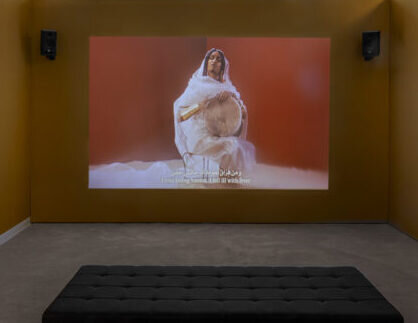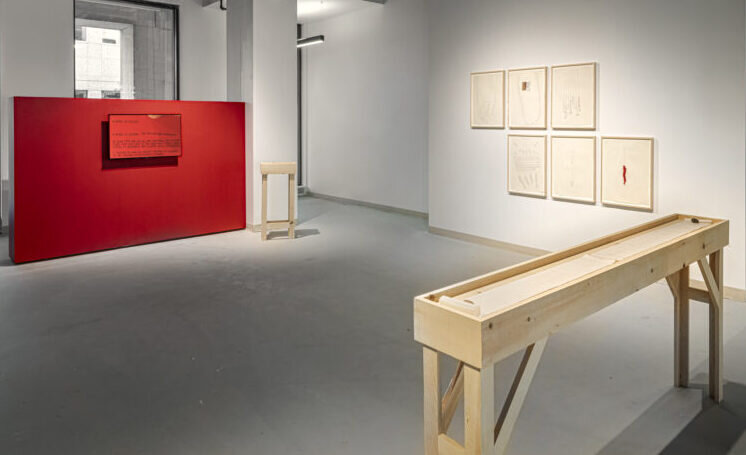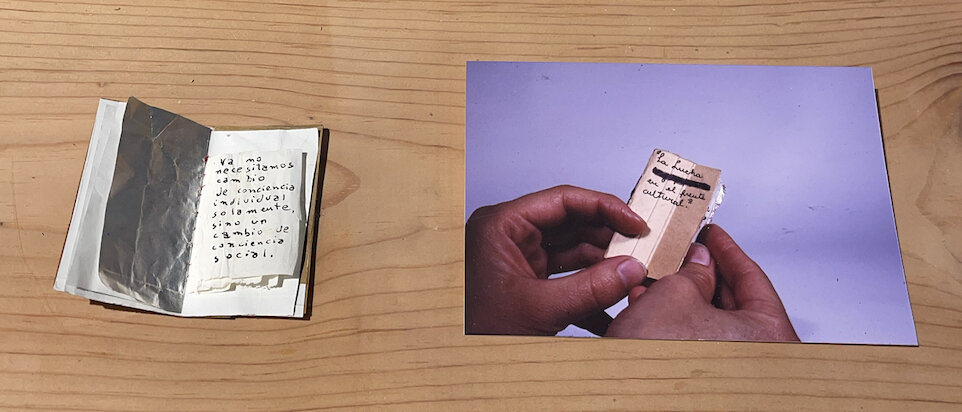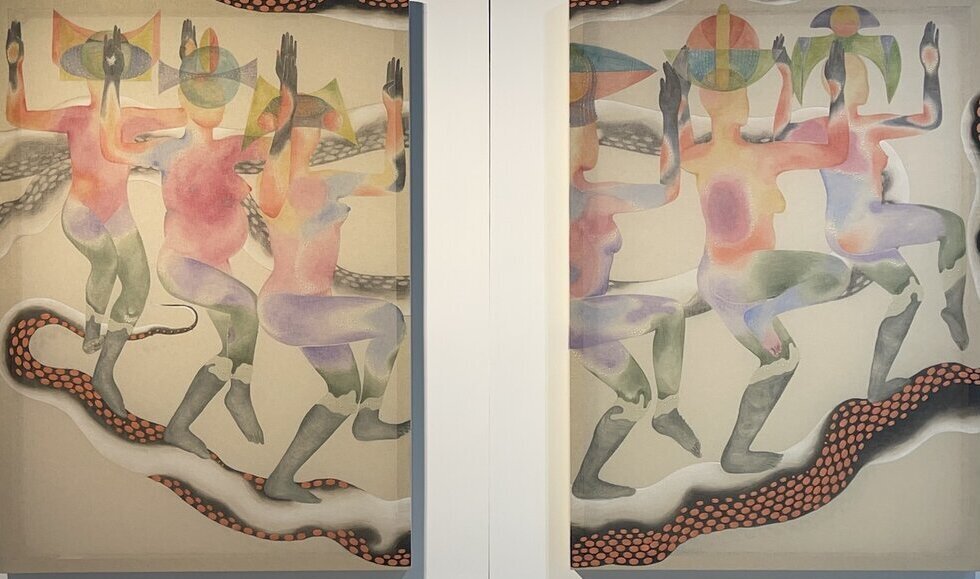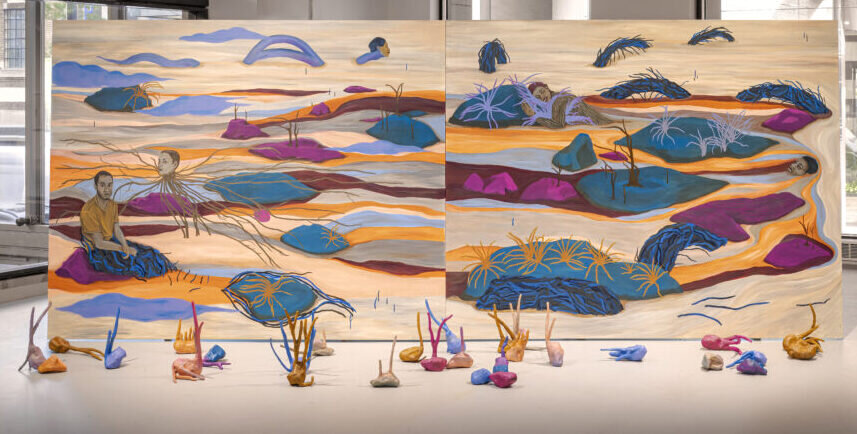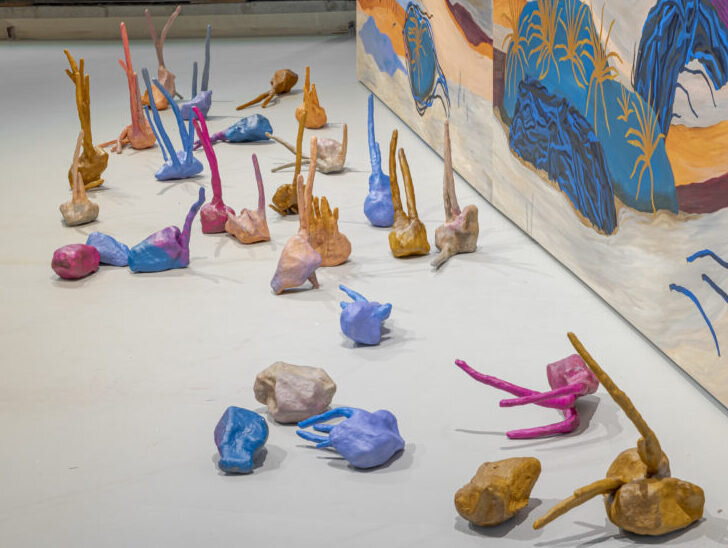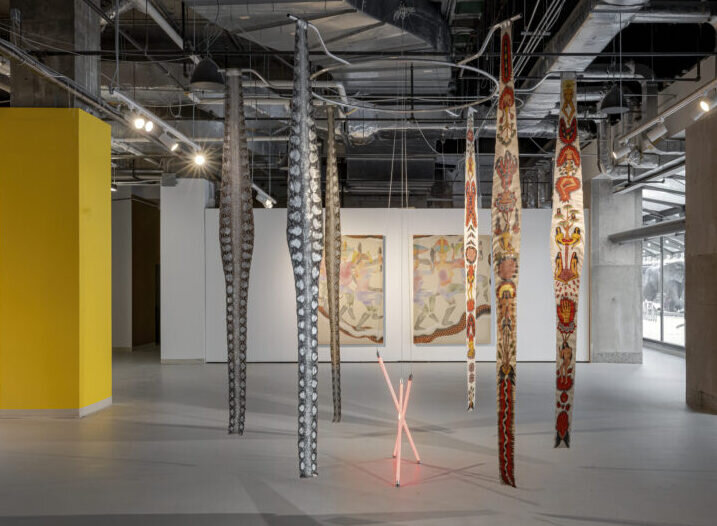Sandwiched between the towering buildings of the financial district is the Collision Gallery, a multifunctional space bridging the gap between the financial and creative culture in Downtown Toronto. Destress and enter a world of mysticism and creativity in an exhibit that focuses on various ethnicities depicted through the stories of self-identity.
Tucked in the back corner is a separate space dedicated to the heartfelt truths of queer lovers. In the dimly lit area, vibrant colors echo off the walls as the video plays in a continuous loop. The secrecy of the space sheds light on the hidden love between queer lovers but the vibrancy of the colors expresses the strength of their emotions. A clandestine meeting to celebrate this form of emotions. Sitting on the black bench, it feels like we are eavesdropping on the whispers of love from one lover to the other. Three Sudanese songs speak the truths from the depth of the heart. The universal understanding of love and music transcends the language barrier. Envisioning the traditional musical instruments and poetic lyrics are pop culture visual aesthetics that take from music videos of famous contemporary artists in terms of color, styling, and camera work. Its bright and cheerful color palette juxtaposes the soft, bittersweet lyrics in describing the conflicting emotions of a secret love.
Ahmed Umar, Truth Bears No Scandal (in Arabic), 2024. Video, 11 minutes, 45 seconds. Courtesy of the artist and OSL Contemporary. Photo: Toni Hafkenscheid
In the opposite corner of the gallery are several works by artist Cecilia Vicuña, who speaks on the topics of oppression and mind-control experiments that have created devastating chapters in our history books. The piece is an homage to Gail Kastner, an eighteen-year-old Canadian girl who endured 64 electroshocks and the forced ingestion of drugs to erase her memory. Kastner left her testimony on written cigarette boxes, that were recreated as part of the installation. Although addressing subjects of grave importance, Vicuña’s approach uses nostalgia, value of words, and abstractness of visual representations to serve as reminders of past cruelty that should not be repeated.
View of Cecilia Vicuña’s Futur.O (Futur.E), an installation in four parts. Courtesy of the artist and Lehmann Maupin, New York, Seoul, and London. Photo: Toni Hafkenscheid
Cecilia Vicuña, A Change of Consciousness, 2024. Little handmade book, made from a found cigarette box (exhibition copy, the original is at Tate Modern), 4.5 x 7.5 cm. Courtesy of the artist and Lehmann Maupin, New York, Seoul, and London. Photo: Sherry Qin
Divided into two separate canvases, Rajni Perera takes the viewer on a spiritual journey through her dreams on top of the serpent. In this ritualistic dance, these mythological creatures are colored in beautiful warm tones that fill up the head and torso contrasted with dark grey hues that highlight the legs, hands, and forearms. The combination of acrylic gouache, metallic thread on polyester fabric, glass and freshwater pearls emphasizes the spiritual and mythological essence of the artwork. Mixed into the work are earthy materials such as clay and charcoal, that connect the dream to the earth, grounding it to Perera’s childhood experiences with craftsmanship. Her grasp of materiality is evident in using numerous clay ovals that evoke the scales of a snake’s skin and pearls strategically placed on the body to emulate etherealness. The mixed media work creates a balance that allows the thin fabric of the canvas to sustain the materials physically and forms a bridge between one and one’s dream-state.
Rajni Perera, Joyous Procession/The Infinite Serpent, 2024. Acrylic gouache, polymer, clay, metallic thread on polyester fabric, glass and freshwater pearls, chalk, charcoal, 213.3 x 152.4 cm each. Courtesy of the artist and Patel Brown Gallery. Photo: Sherry Qin
Tessa Mars explores the relation between the body and the land, focusing on the human impact on the environment and the damage to ecosystems. The heart-shaped papier-mâché objects laid out on the floor project the relationship between the body and the land, solidifying it in a three-dimensional world. Metamorphic transitions are depicted in the large canvas as human body parts merge with small islands floating on murky waters. Mars suggests to the viewers to reflect upon themselves and their destruction of nature. She encourages the audience to feel the urgency to undone the damage they caused and support the ecosystem.
Tessa Mars, All Islands Touch, 2024. Acrylic on canvas, and papier-mâché. Paintings: 200 x 250 cm each. Installation: dimensions variable. Courtesy of the artist. Photo: Toni Hafkenscheid
In her work Citra Sasmita integrates technological innovations into Balinese mythology and spirituality. She uses Kamasan-style painting, developed in the fifteenth century as one of the first painting method in Bali, to tackle themes of colonialism and patriarchy through traditional stories, whilst addressing the analogy that myths offer for modern science. The installation resembles a gathering around a campfire, where the metal holding the snakeskin continuously rotate back and forth, mimicking a ritualistic dance around the campfire. The neon red lamps position themselves in the center, huddling together like firewood, lighting up the surrounding space to create effects like that of a fire. Together with the metal, Sasmita seamlessly integrated technological advancements from the Western world into the world of Balinese mythology and traditional stories.
Citra Sasmita, Timur Merah Project XII: Light Speed and Revelation, 2024. Kamasan traditional canvas, Python Reticulatus snakeskin, metal, and neon lamps. Metalwork by Sparkers Fabrication. Courtesy of the artist. Photo: Toni Hafkenscheid
Sherry Quin
* Exhibition information: Toronto Biennial of Art, September 21 – December 1, 2024, 11 locations in the city. Collison Gallery, 30 Wellington Street W, Commerce Court Toronto. Gallery hours: Tue -Sat: 10 am – 6 pm. For TBA programming please click here.

